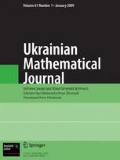Abstract
A linear relation S is called a proper extension of a symmetric linear relation S if S ⊂ S ⊂ S*. As is well known, an arbitrary dissipative extension of a symmetric linear relation is proper. In the present paper, we establish criteria for an accretive extension of a given positive symmetric linear relation to be proper.
Similar content being viewed by others
References
E. A. Coddington and H. S. U. de Snoo, “Positive self-adjoint extensions of positive symmetric subspaces,”Math. Z.,159, 203–214 (1978).
R. S. Phillips, “Dissipative operators and hyperbolic systems of partial differential equations,”Trans. Amer. Math. Soc.,90, 192–254 (1959).
T. Kato,Perturbation Theory for Linear Operators, Springer, Berlin-Heidelberg-New York (1966).
T. Ando and K. Nishio, “Positive selfadjoint extensions of positive operators,”Tohoku Math. Z.,22, 65–75 (1970).
M. G. Krein, “Theory of self-adjoint extensions of semibounded Hermitian operators and its applications. I, II,”Mat. Sb.,20, No. 3, 431–490;21, No. 3, 366–404 (1947).
Yu. M. Arlinskii and é. R. Tsekanovkii, “Nonself-adjoint contracting extensions of Hermitian contractions and the Krein theorems,”Usp. Mat. Nauk,37, No. 1, 131–132 (1982).
Yu. M. Arlinskii and é. R. Tsekanovkii, “quasi-self-adjoint contracting extensions of Hermitian contractions,”Teor Funkts.,Funkts. Anal. Prilozhen., Issue 50, 9–16 (1988).
W. N. Anderson and G. E. Trapp, “Shorted operators,”SIAM J. Appl. Math.,28, No. 1, 60–71 (1975).
B. Sz.-Nagy and C. Foias,Analyse Harmonique des Opérateurs de l'Espace de Hilbert [Russian translation], Mir, Moscow (1970).
A. N. Kochubei, “On extensions of a positive-definite operator,”Dokl. Akad. Nauk Ukr. SSR, Ser. A, No. 3, 168–171 (1979).
V. A. Mikhailets, “Spectra of operators and boundary-value problems,” in:Spectral Analysis of Differential Operators [in Russian], Institute of Mathematics, Ukrainian Academy of Sciences, Kiev (1980), pp. 106–131.
V. A. Derkach and M. M. Malamud,Weyl Function of an Hermitian Operator and Its Relationship with the Characteristic Function [in Russian], Preprint No. 85-9 (104), Physicotechnical Institute, Ukrainian Academy of Sciences, Donetsk (1985).
V. A. Derkach, M. M. Malamud and é. R. Tsekanovskii, “Sectorial extensions of a positive operator and the characteristic function,”Ukr. Mat. Th.,41, No. 2, 151–158 (1989).
O. G. Storozh, “Description of some classes of extensions of a nonnegative operator,”Dokl. Akad. Nauk Ukr. SSR, Ser. A, No. 10, 15–17 (1987).
O. G. Storozh, “Extremal extensions of nonnegative operators and accretive boundary-value problems,”Ukr. Mat. Zh.,42, No. 6, 858–860 (1990).
Yu. M. Arlinskii, “Positive spaces of boundary values and sectorial extensions of nonnegative symmetric operators,”Ukr. Mat. Zh.,40, No. 1, 8–14 (1988).
O. Ya. Mil'o and O. G. Storozh, “On the general form of accretive extensions of positive-definite operators,”Dokl. Akad. Nauk Ukr. SSR, Ser. A, No. 6, 19–22 (1991).
Author information
Authors and Affiliations
Additional information
Published in Ukrainskii Matematicheskii Zhurnal, Vol. 47, No. 6, pp. 723–730, June, 1995.
Rights and permissions
About this article
Cite this article
Arlinskii, Y.M. On proper accretive extensions of positive linear relations. Ukr Math J 47, 831–840 (1995). https://doi.org/10.1007/BF01058773
Received:
Issue Date:
DOI: https://doi.org/10.1007/BF01058773


